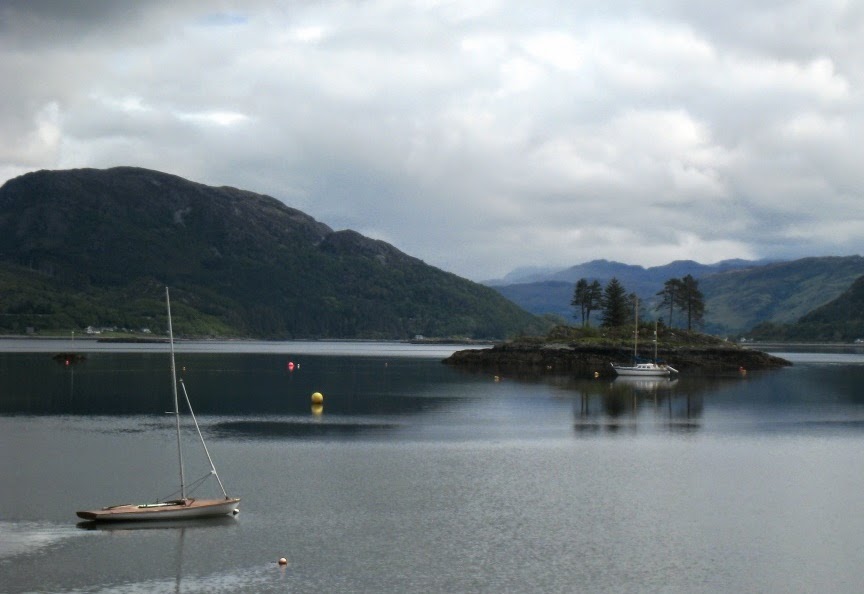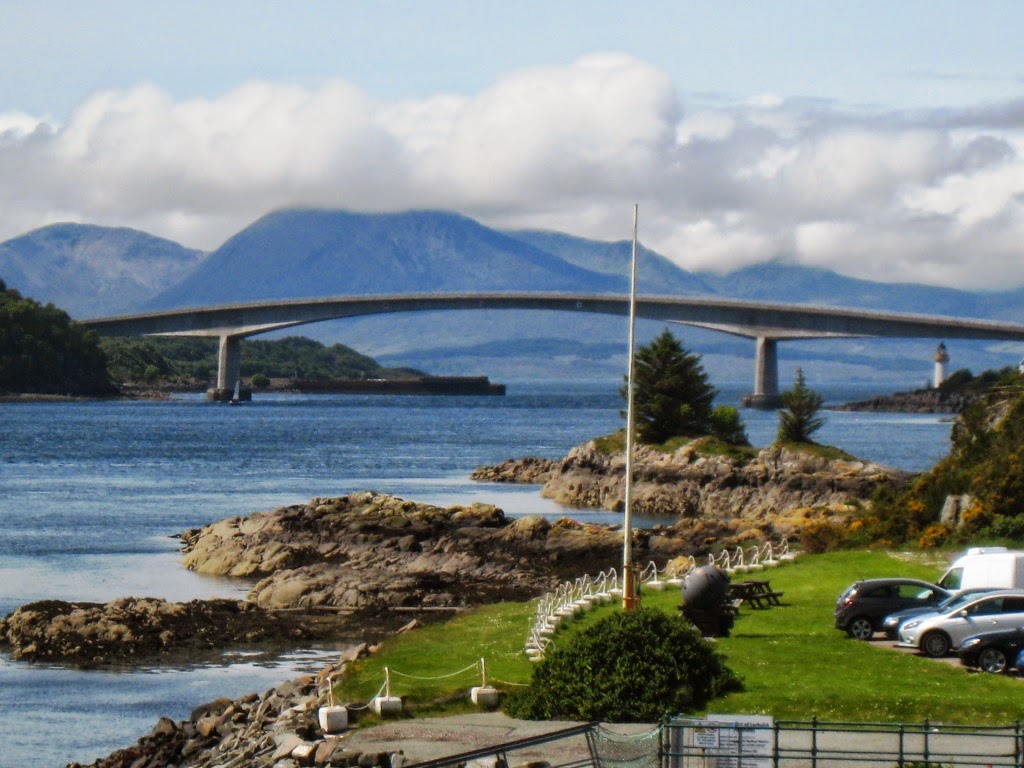The first thing we noticed when we crossed into Scotland was
the proliferation of speed cameras on the motorway. There seemed to be one every couple of miles.
There were other things we noticed too. First, the roads weren’t “hedged in”.
You could actually see the countryside and we really enjoyed driving in general
much more in Scotland.
 |
| This amazing sculpture is one of two under construction beside the motorway south of Edinburgh. They are quite impressive! |
Our first destination was Stirling Castle, just west of
Edinburgh. When we saw lots of cars parked a little down the hill from the
castle, we too pulled into one of the last parking spots and walked up the
hill. It was a good decision as it cost £4 just to park at the castle carpark.
Our English Heritage pass also got us in at half price so we had a win on both
counts. The castle itself was one of the best we have seen. It sits imposingly
atop a hill in the middle of town and is surrounded on three sides by steep
cliffs. It is in much better repair than those we saw in England and more
effort has been taken with historical displays etc.
Most of the principal buildings
of the castle are from the fifteenth and sixteenth centuries but a few
fourteenth century structures remain. The outer defences fronting the town date
from the early eighteenth century. Several Scottish Kings and Queens have been
crowned at Stirling, including Mary,
Queen of Scots, in 1542. There have been at least eight sieges of the Castle,
several during the Wars of Scottish Independence. The last was in 1746, when Bonnie
Prince Charlie unsuccessfully tried to take the castle.
At the entrance is an imposing statue of Robert the Bruce but it was surrounded
by scaffolding and obviously being repaired or cleaned.
The Great Hall was the largest
banqueting hall ever built in medieval Scotland. Its roof was replaced in 1964,
built the same as the original hammerbeam roof, and using 350 oak trees.
Apparently, three new trees were planted for every one cut down.
The views from the castle walls were impressive.
 |
| The layout of the King's Garden (left) and the Queen's Garden (right) can still be seen even today. |
Inside the palace proper is very ornate. The locals in period costume also proved extremely entertaining, one even letting me hold his horn (unicorn horn that is) while he showed John some amusing paintings in the Queen’s bedchamber.
 |
| Exterior of the Palace proper |
 |
| Sitting room ceiling. |
 |
| The King's bedchamber |
 |
| The Queen's bedchamber |
 |
| The banquet hall complete with page and "horn". Unicorns are used in decorations extensively throughout the castle as well as on the coat of arms. |
Stirling Castle is also home to the
Argyll & Sutherland Highlanders Regimental Museum where, as well as the
Regimental history, we saw several impressive and unusual items.
 |
| Snuff mull from the officers' mess. Snuff is stored in the silver bowl at the front of the head while cigars were stored in the bowl at the back. |
 |
| Ornate centrepiece for the dining table at the officers' mess. |
 |
| The William Wallace Monument can be seen at top left atop the green outcrop in the distance. |
 |
| Storming Stirling Castle would have been quite a feat! |
 |
| These two littlies were having fun with dress-ups. |
 |
| This is a great example of the slate shingle roofs which are used in many of the buildings around the castle. |
From Stirling we travelled north through Crieff to
Dunkeld. Then it was north-west over Grampian Mountains. The countryside was
lovely and we passed some amazing old houses.
We also started seeing some of the hundreds of lochs or
lakes that dot the Scottish landscape. At Spean Bridge we turned north again
and drove past Loch Lochy to Fort Augustus at the southern end of Loch Ness.
Along the way we saw the Caledonian Canal for the first time. It is actually
one of a series of canals that link Beauly Firth at Inverness in the north with
Loch Ness, Loch Oich, Loch Lochy and Loch Linnhe at Fort William then into the
Firth of Lorn, thus enabling shipping to bypass the more rough seas to the
north of Scotland and go from the North Sea to the Irish Sea. It was the first
system of lochs in the world and is an amazing engineering feat. Quite large
ships still navigate through the lochs today. We were to see the complete set
of lochs during our few days in Scotland as we drove south through Fort William
at the southern end of the lochs when we returned to England.
Our B&B on the Moriston River was lovely, set in
little dead-end lane not far from Invermoriston. We decided to stay in the area
for longer and the guys at Serendipity (our B&B) arranged for us to stay at
another just up the road for the next two days.
 |
| The garden at Tigh-Litrichean |
 |
| This little guy, Rum, won our hearts here as well. |
 |
| Early morning view from our bathroom window. |
We dropped our bags off there
next morning and set off for the Isle of Skye. The scenery along the way was beautiful.
 |
| One of the many dams built along the lochs which provide hydro-electricity to Scotland. |
 |
| Loch Cluanie |
First we stopped off to look at Eilean Donan Castle near Dornie on the way to the island. It has
an interesting history. Check out the link if you want to learn more.
Next it was off to a beautiful little fishing village
called Plockton on the shores of Loch Carron.
 |
| Along the road to Plockton. |
The tide was out so we were able
to walk out to a little island in the middle of the harbour. The view on the
other side was stunning. We just couldn’t stop taking photos.
On the way back we stopped off at a beautiful little
village called Diurinish. Here we discovered a herd of Scottish highland cattle
that roams freely throughout the village. They are delightful animals and are obviously
used to lots of attention from passing motorists.
 |
| Highland bull |
Next it was on through Kyle of Lochalsh and over the
impressive 500 metre long Skye Bridge.
Once on the island we quickly saw why it is one of the
most visited places in Scotland. While driving up to Portree we passed the
little settlement of Breakish and discovered a quaint little secondhand store
similar to some we had seen in the states. The car park was encircled by tables
covered in crockery etc which is obviously left there willy-nilly by anyone and
everyone. We had a great time browsing through both the inside and outside and
also enjoyed a long and amusing chat with the proprietors, a lovely couple who
obviously loved a laugh.
 |
| The wind must get strong here. This thatched roof was held down with wire netting with heavy rocks attached. |
From Portree we drove west over the hills to the little
village of Struan and then back across to Sligachan. It was a beautiful drive.
The landscape on Skye is beautiful and wild.
 |
| The west coast of Skye. |
 |
| I call these "Zorro" sheep. They seem a popular breed in Scotland. |
We had a lovely day, topped off
with a lovely dinner cooked by our host Ben at Tigh-Litrichean, our B&B. Unfortunately
Ben is leaving the area so we can’t say go there, as it probably won’t be there
soon. Serendipity will be though and it is great too.
Our next day was spent circumnavigating Loch Ness, with a stop
off and walk around Foyers Falls on the eastern side of Loch Ness. We also
stopped off at a spot where the locals go to build stone cairns dedicated to
deceased friends and family.
 |
| The southern end of Loch Ness. We didn't see Nessy! |
 |
| Commemorative rock cairns |
Inverness was a busy city even on a Sunday. We saw
hundreds of ladies participating in a fun run accompanied by bagpipes. On the
way back down to Invermoriston we also passed several guys on scooters who were
doing a charity ride similar to Australia’s postie-bike run.
 |
| In Drumnadrochit we had a delicious lunch of "Cullen's skink", a lovey smoked haddock, potato and leek soup. |
That night we drove into Fort Augustus for dinner and took
a look at the canal and loch there. We noticed there was a large cruise boat
moored at the dock. It is light until very late here and on the way home at
about 9 pm we could still stop off for photos on the lake.
 |
| Loch Ness |
Ben said we should go through Glencoe on our way back to
England and it was certainly a beautiful drive. The calm of the morning
provided some magic photos at Loch Linnhe and then just past Glencoe the
mountains provided breathtaking scenery all the way to Crianlarich.
 |
| Loch Linnhe |
 |
| We walked across the peat to this spot. It feels like you are walking on a dense sponge. |
We pulled
off the A74 at a little town called Moffat, famous for its toffee, where we had
a lovely dinner at the local Indian restaurant.
 |
| Main street, Moffat |
Next day, after some shopping
for toffee and some bargains at the local woollens shop, we headed down to
Liverpool before catching the ferry for the next leg, and main reason for our
trip, The Isle of Man and the TT.































No comments:
Post a Comment